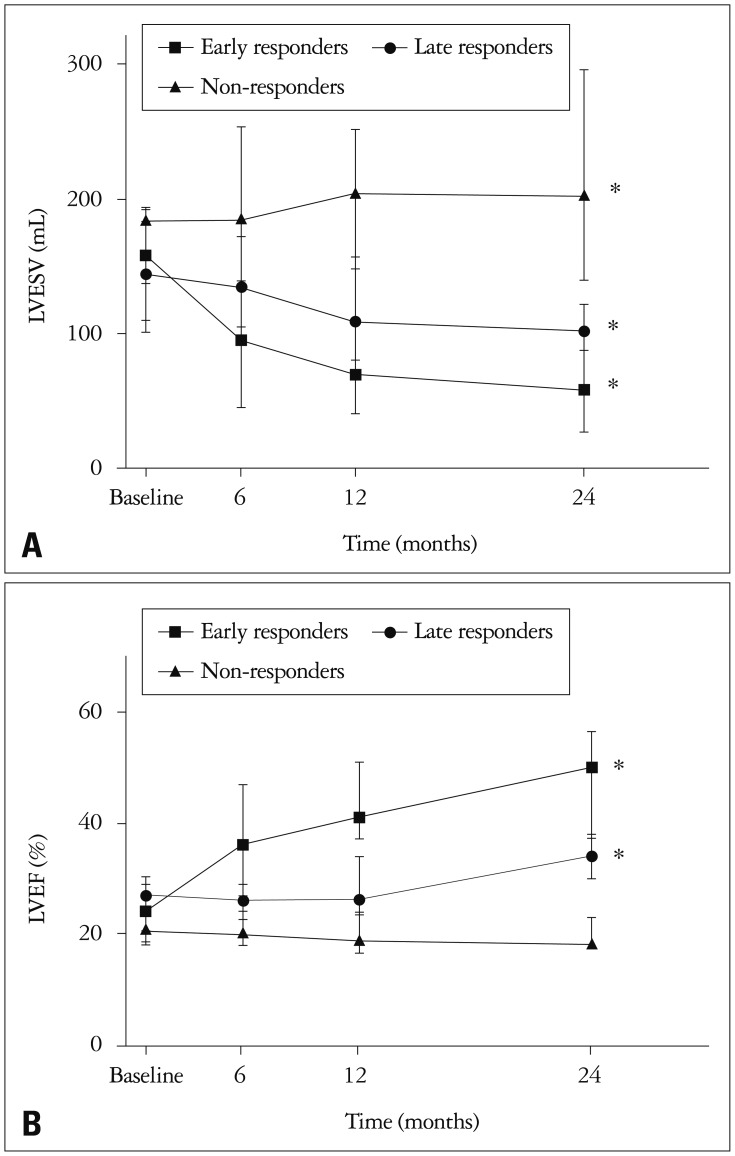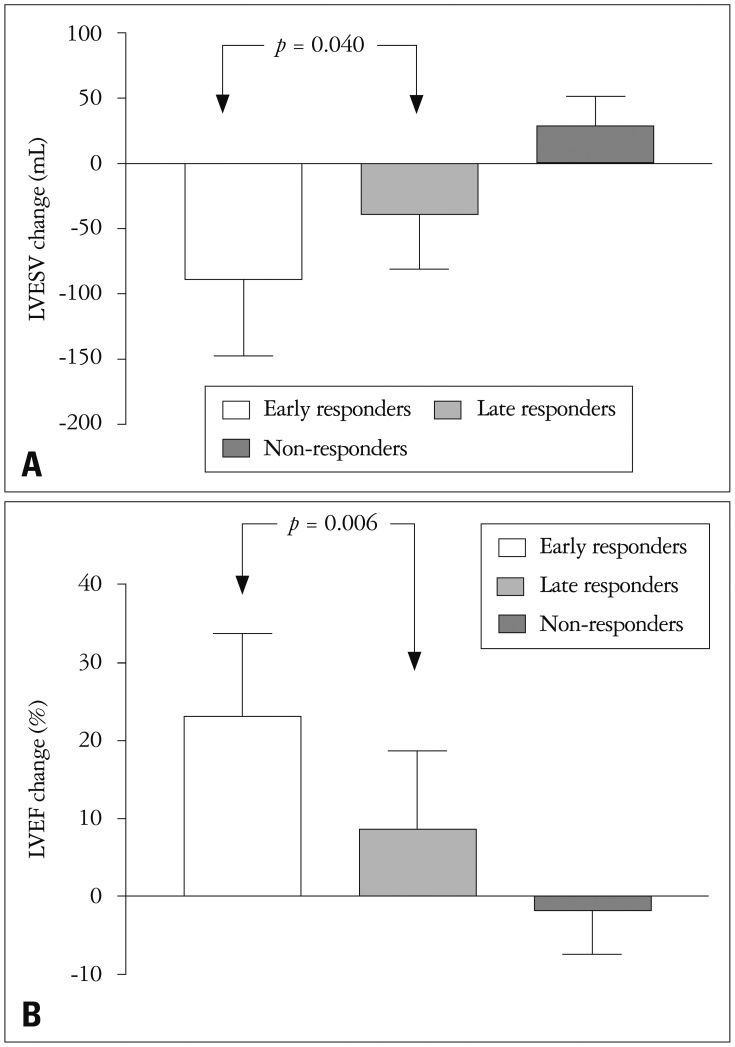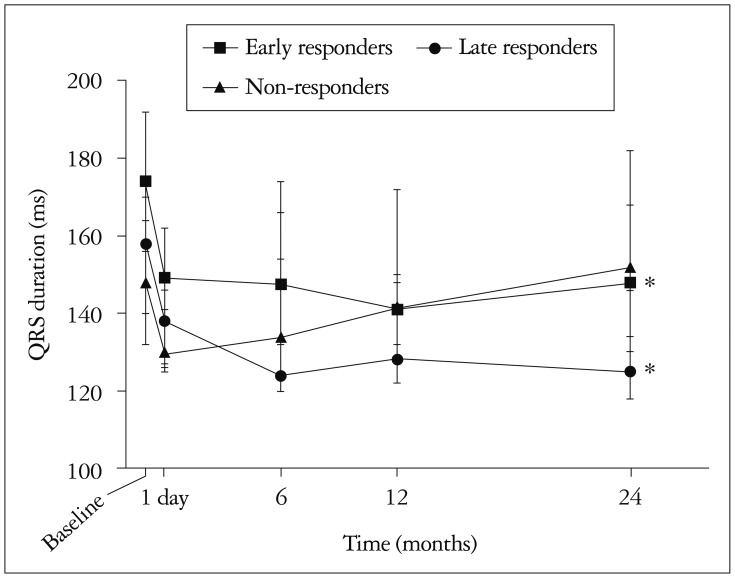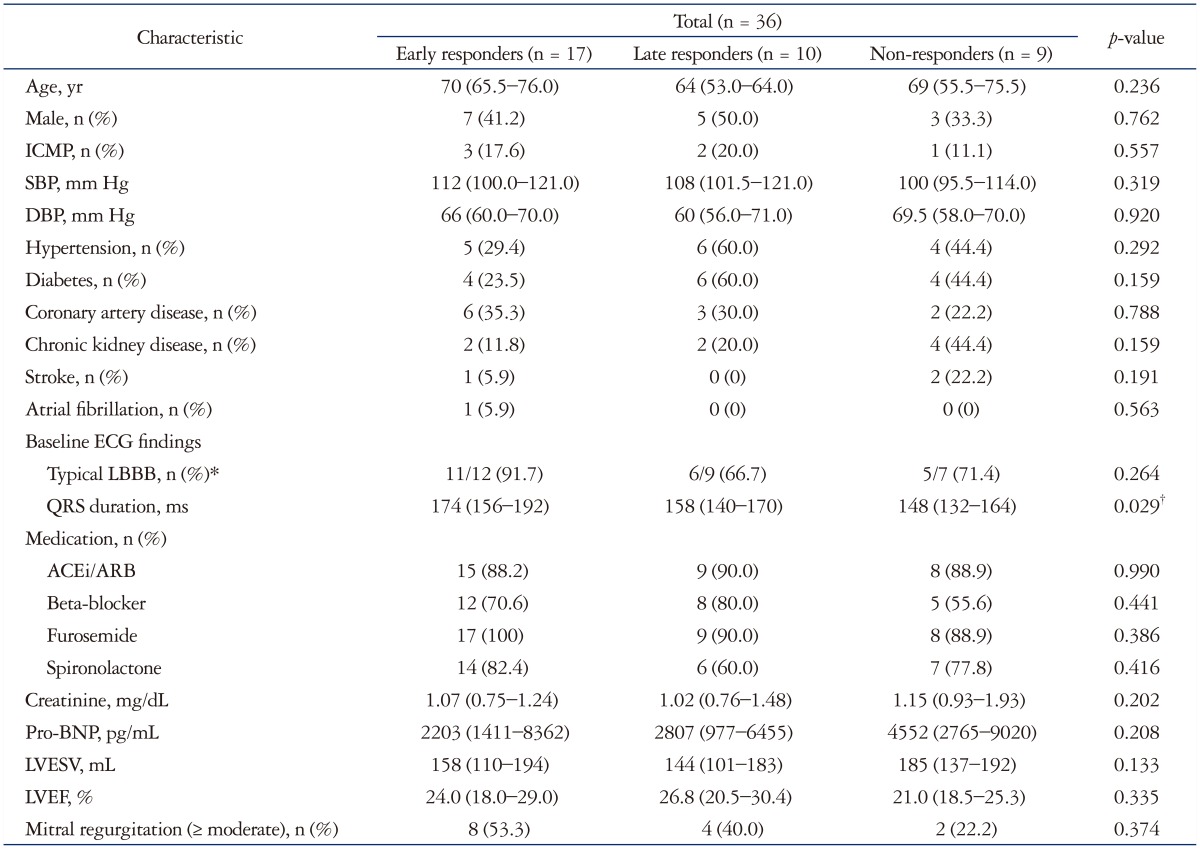1. St John Sutton MG, Plappert T, Abraham WT, Smith AL, DeLurgio DB, Leon AR, Loh E, Kocovic DZ, Fisher WG, Ellestad M, Messenger J, Kruger K, Hilpisch KE, Hill MR; Multicenter InSync Randomized Clinical Evaluation (MIRACLE) Study Group. Effect of cardiac resynchronization therapy on left ventricular size and function in chronic heart failure. Circulation. 2003; 107:1985–1990. PMID:
12668512.
2. Yu CM, Bleeker GB, Fung JW, Schalij MJ, Zhang Q, van der, Chan YS, Kong SL, Bax JJ. Left ventricular reverse remodeling but not clinical improvement predicts long-term survival after cardiac resynchronization therapy. Circulation. 2005; 112:1580–1586. PMID:
16144994.
3. Chung ES, Leon AR, Tavazzi L, Sun JP, Nihoyannopoulos P, Merlino J, Abraham WT, Ghio S, Leclercq C, Bax JJ, Yu CM, Gorcsan J 3rd, St John Sutton M, De Sutter J, Murillo J. Results of the Predictors of Response to CRT (PROSPECT) trial. Circulation. 2008; 117:2608–2616. PMID:
18458170.
4. Friedman DJ, Upadhyay GA, Rajabali A, Altman RK, Orencole M, Parks KA, Moore SA, Park MY, Picard MH, Ruskin JN, Singh JP, Heist EK. Progressive ventricular dysfunction among nonresponders to cardiac resynchronization therapy: baseline predictors and associated clinical outcomes. Heart Rhythm. 2014; 11:1991–1998. PMID:
25106864.
5. Marfella R, Di Filippo C, Potenza N, Sardu C, Rizzo MR, Siniscalchi M, Musacchio E, Barbieri M, Mauro C, Mosca N, Solimene F, Mottola MT, Russo A, Rossi F, Paolisso G, D'Amico M. Circulating microRNA changes in heart failure patients treated with cardiac resynchronization therapy: responders vs. non-responders. Eur J Heart Fail. 2013; 15:1277–1288. PMID:
23736534.
6. Ghio S, Freemantle N, Scelsi L, Serio A, Magrini G, Pasotti M, Shankar A, Cleland JG, Tavazzi L. Long-term left ventricular reverse remodelling with cardiac resynchronization therapy: results from the CARE-HF trial. Eur J Heart Fail. 2009; 11:480–488. PMID:
19287017.
7. van't Sant J, Fiolet AT, ter Horst IA, Cramer MJ, Mastenbroek MH, van Everdingen WM, Mast TP, Doevendans PA, Versteeg H, Meine M. Volumetric response beyond six months of cardiac resynchronization therapy and clinical outcome. PLoS One. 2015; 10:e0124323. PMID:
25933068.
8. Molhoek SG, VAN Erven L, Bootsma M, Steendijk P, Van Der Wall EE, Schalij MJ. QRS duration and shortening to predict clinical response to cardiac resynchronization therapy in patients with end-stage heart failure. Pacing Clin Electrophysiol. 2004; 27:308–313. PMID:
15009855.
9. Abraham WT, Fisher WG, Smith AL, Delurgio DB, Leon AR, Loh E, Kocovic DZ, Packer M, Clavell AL, Hayes DL, Ellestad M, Trupp RJ, Underwood J, Pickering F, Truex C, McAtee P, Messenger J. MIRACLE Study Group. Multicenter InSync Randomized Clinical Evaluation. Cardiac resynchronization in chronic heart failure. N Engl J Med. 2002; 346:1845–1853. PMID:
12063368.
10. Birnie DH, Tang AS. The problem of non-response to cardiac resynchronization therapy. Curr Opin Cardiol. 2006; 21:20–26. PMID:
16355025.
11. Bleeker GB, Bax JJ, Fung JW, van der Wall EE, Zhang Q, Schalij MJ, Chan JY, Yu CM. Clinical versus echocardiographic parameters to assess response to cardiac resynchronization therapy. Am J Cardiol. 2006; 97:260–263. PMID:
16442375.
12. Burns KV, Gage RM, Curtin AE, Bank AJ. Long-term echocardiographic response to cardiac resynchronization therapy in initial nonresponders. JACC Heart Fail. 2015; 3:990–997. PMID:
26577619.
13. Zhang J, Zhang Y, Zhou X, Li J, Li Y, Zhang Y, Xu G, Xing Q, Lin S, Tang B. QRS duration shortening predicts left ventricular reverse remodelling in patients with dilated cardiomyopathy after cardiac resynchronization therapy. Acta Cardiol. 2015; 70:307–313. PMID:
26226704.
14. Brabham WW, Gold MR. The role of AV and VV optimization for CRT. J Arrhythm. 2013; 29:153–161.
15. Ellenbogen KA, Gold MR, Meyer TE, Fernndez Lozano I, Mittal S, Waggoner AD, Lemke B, Singh JP, Spinale FG, Van Eyk JE, Whitehill J, Weiner S, Bedi M, Rapkin J, Stein KM. Primary results from the SmartDelay determined AV optimization: a comparison to other AV delay methods used in cardiac resynchronization therapy (SMART-AV) trial: a randomized trial comparing empirical, echocardiography-guided, and algorithmic atrioventricular delay programming in cardiac resynchronization therapy. Circulation. 2010; 122:2660–2668. PMID:
21098426.
16. Kosmala W, Marwick TH. Meta-analysis of effects of optimization of cardiac resynchronization therapy on left ventricular function, exercise capacity, and quality of life in patients with heart failure. Am J Cardiol. 2014; 113:988–994. PMID:
24461769.









 PDF
PDF ePub
ePub Citation
Citation Print
Print


 XML Download
XML Download